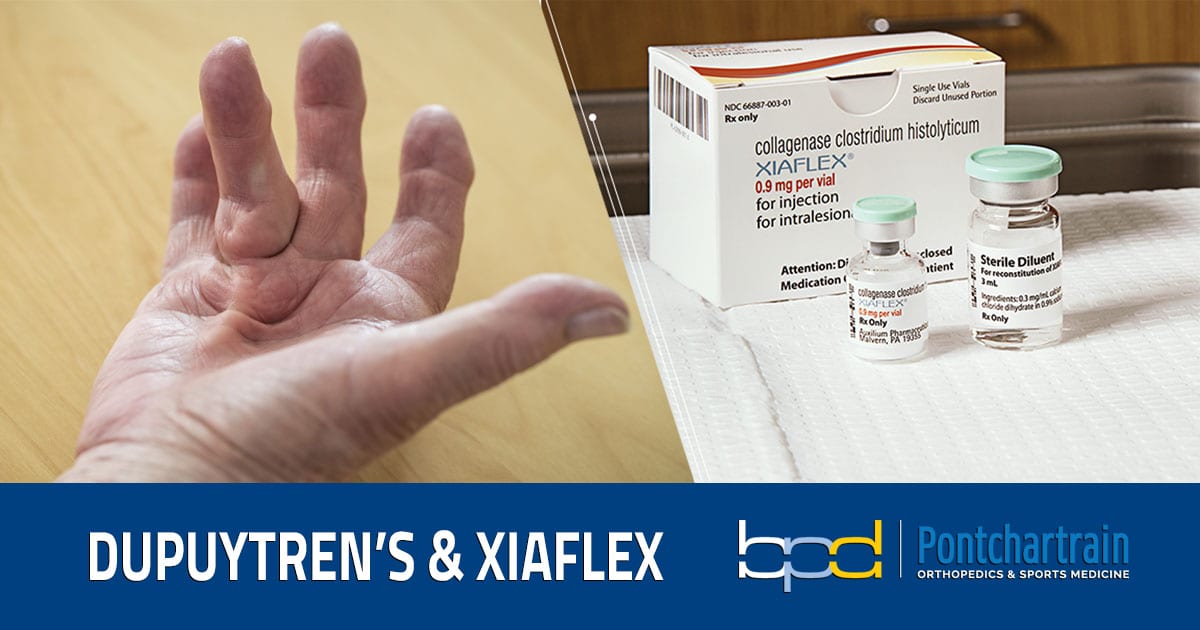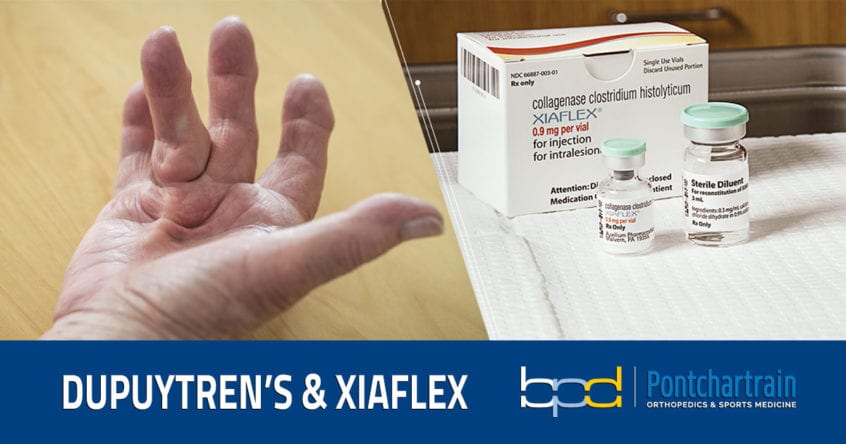
Treating Dupuytren’s contractures with Xiaflex is a relatively new therapy for thousands who suffer from this potentially crippling deformity of the hand. In today’s post, Dr. Donnelly discusses Dupuytren’s contracture, the origins of this disfiguring and painful condition, and an array of treatment options.
What is Dupyutren’s Contracture?
Dupuytren’s contracture, also known as Dupyutren’s Disease or palmar fibromatosis is named after Guilliame Dupyutren, a famous french surgeon during the Napoleanic era. Dupuytren’s contracture is an abnormal thickening of the tissue just beneath the skin. This thickening occurs in the palm and can extend into the fingers. Firm pits, bumps and cords (thick lines) can develop and cause the fingers to bend into the palm.
What are the Symptoms of a Contracture?
Collagen builds up in the hand beneath the surface of the skin. The collagen thickens into a rope-like cord that extends from the palm to the finger. As Dupuytren’s progresses, these ropes tighten, pulling one or more fingers into a bent position. It can become impossible to straighten the fingers, making every-day activity awkward or impossible. The symptoms include:
Callus-like Lump or Skin Pit/Dimples
Dupuytren’s contracture typically affects fingers farthest from the thumb, however it is not exclusive to ring or small finger. It begins with the development of one or more nodules, or callus-like lumps, under the skin in the palm. The nodules can also cause pits where the skin adheres to this tissue and looks like a dimple. People tend to assume these will go away on their own, so the condition often progresses over a lengthy period of time before patients seek medical treatment.
Clinched Fingers
One hand may have more severe symptoms, but both can be impacted. As the fingers curl forward, sufferers can become unable to shake hands, grip things, put on gloves or enjoy their favorite hobbies.
Who Gets It and Why?
The cause remains unknown, though older men are the most susceptible to Duputren’s contracture. Though the condition typically runs in families of Northern European and Scandinavian descent (Vikings), it can impact people of any background. Smoking can lead to an increased risk; excessive use of alcohol is also associated with Dupuytren’s.
The presentation and severity is variable as well, not everyone who develops nodules or pits will develop a contracture. However, when it occurs in people less than 50 years old, it is typically more aggressive.
How Is It Treated?
There is no cure for the condition, but fortunately most mild cases can be treated with simple observation. One tool used to determine if treatment is indicated is called the table top sign. If you try to lay your hand flat on a table and are unable to touch your palm to the table, your contracture may require treatment.
A variety of treatments have been developed over the years, some working better than others. These include steroid injections, enzyme injections, needle aponeurotomy, and surgical excision.
Patients with advanced Dupuytren’s contractures may require surgery. This procedure involves removing the susceptible tissue, and sometimes releasing the contracted joint. This is more invasive and results in longer healing and recovery. It may also require a skin graft.
“Treating Dupuytren’s contractures with Xiaflex (collagenase enzyme injection) offers an in-office minimally invasive option.”Brandon P. Donnelly, MD
Treating Dupuytren’s contractures with Xiaflex (collagenase enzyme injection) offers an in-office minimally invasive option: Studies have shown that this injection can help straighten affected fingers and improve range of motion. Treatment also involves a finger-extension procedure, a splint at bedtime for up to four months, and regular daily finger exercises. Some cases may require repeat injection to get desired correction.
Discuss Treating Dupuytren’s contractures with Xiaflex
You may be related to Vikings, but don’t try to tough it out. The earlier treatment begins with Dupuytren’s contracture, the better. A lump on your palm may seem harmless, but it could be an important early indicator.
If your finger is starting to curl or you found a lump on your hand, contact Dr. Donnelly’s office to schedule an appointment today. Early intervention is the key to maintaining your quality of life.
About Dr. Brandon P. Donnelly, MD
 Dr. Brandon P. Donnelly is a board certified orthopedic surgeon with Pontchartrain Orthopedics & Sports Medicine. Dr. Donnelly completed his hand and microsurgery fellowship at the prestigious Philadelphia Hand to Shoulder Center. Dr. Donnelly treats all ages of patients in the greater New Orleans area for hand, wrist, and elbow conditions.
Dr. Brandon P. Donnelly is a board certified orthopedic surgeon with Pontchartrain Orthopedics & Sports Medicine. Dr. Donnelly completed his hand and microsurgery fellowship at the prestigious Philadelphia Hand to Shoulder Center. Dr. Donnelly treats all ages of patients in the greater New Orleans area for hand, wrist, and elbow conditions.
This site is not intended to and does not provide medical advice, professional diagnosis, opinion, treatment or services to you or to any other individual. Through this website and links to other websites, Brandon P. Donnelly, MD provides general information for educational purposes only. The content provided in this website and links, is not a substitute for medical care or treatment. You should not use this information in place of a consultation or the advice of your healthcare provider. Brandon P. Donnelly, MD is not liable or responsible for any advice, course of treatment, diagnosis or any other information, services or product you obtain through this site.

